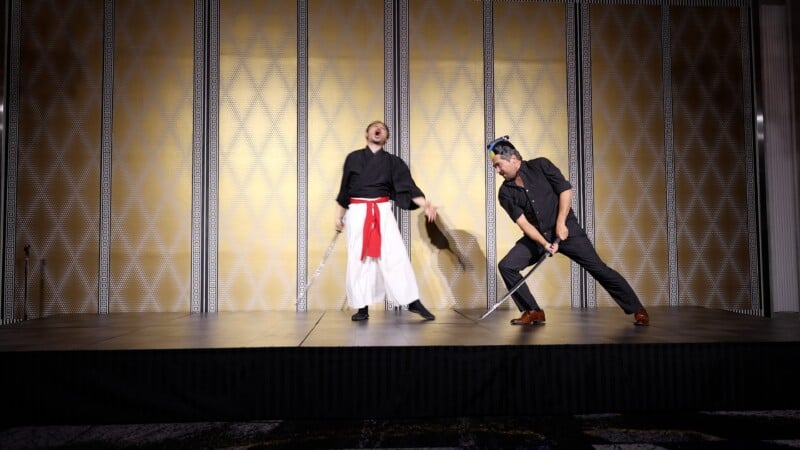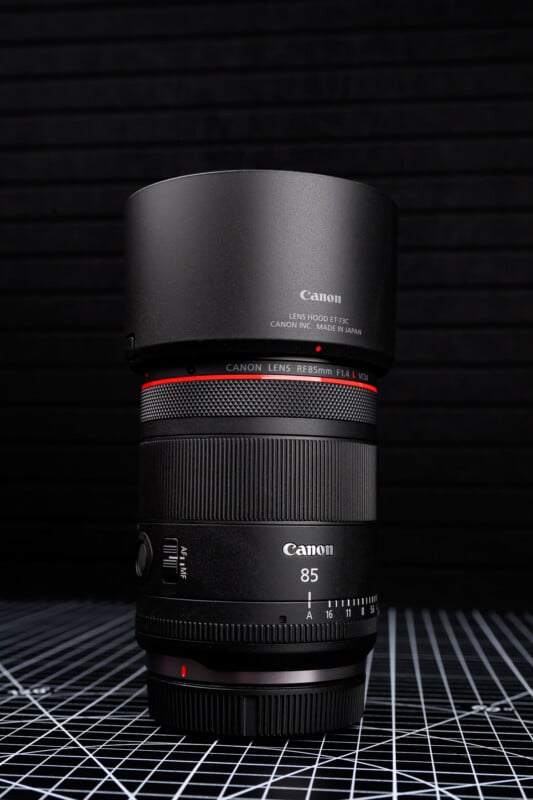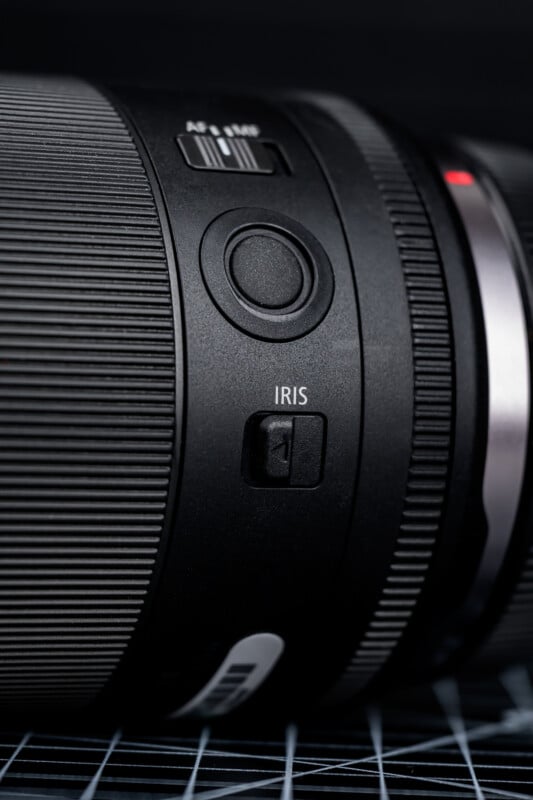Canon RF 85mm f/1.4L VCM Review: Truly a Hybrid Lens
Two things that I love are 85mm lenses and Tokyo, Japan. I was fortunate to experience both, and PetaPixel‘s Jeremy Gray joined me for a week in Japan to visit Canon headquarters and the Utsunomiya optical factory. We missed Jordan on this trip, but Jeremy had never before visited Japan, and we wanted him to experience all that it has to offer for the first time.
This quick trip across the ocean was not for a new product but rather was just so that we could meet the talented people behind Canon’s camera and lens design and manufacturing. Still, I wanted to make use of the gorgeous locations in order to review the newly released Canon RF 85mm f/1.4L VCM — and find out if these new hybrid VCM lenses are just as good for photo applications as they are for video.

This $1,649 L-series 85mm lens joins a plethora of other prime lenses in the same series, with the intention of being equally good for your photo and video needs. But are there some compromises involved when trying to go in two different directions?

Canon RF 85mm f/1.4L VCM Review: How It Feels
One of the most useful features to implement on cinema-forward optics is a near identical size, weight, and light-gathering capability across the board. Canon makes a 20mm, 24mm, 35mm, 50mm, and now an 85mm in this series, and all of these primes have f/1.4 apertures and 67mm filter threads. They are similar in weight, with the 85mm coming in at 22.43 ounces (635 grams), and are essentially the same length and diameter. This allows a videographer to switch lenses on the fly and use the same filters, the same indexing settings for items like follow focus units, and have the same point of balance on gimbals.


Controls are generous with a customizable click-stop ring on the front of the lens, a smooth-turning manual focus ring, and an aperture control ring near the base of the lens. There is a selector switch for AF/MF, a customizable button on the side, and an iris lock button to allow the aperture ring to be locked in “A” mode. This ring does not have any option to switch to a click-stop functionality and can only be manipulated with a smooth turn.


Videographers will likely prefer the smooth function of the aperture ring, but I far prefer the option to have click-stops and the haptic feedback that goes along with it. I simply chose to get around this by locking the aperture function and using a command dial on the body instead. The lens comes with a simple plastic bayonet-locking hood with a locking tab, and as with all L-series lenses, it is weather-sealed to a high degree.


Canon RF 85mm f/1.4L VCM Review: How It Shoots
The autofocusing motor is described in the lens’s name. This lens uses a voice coil motor (VCM), which makes sense given that videographers will want smooth and quiet AF, and photographers will want speed. The Canon VCM provides both, and I had no issues keeping up with the action. The PetaPixel team shot the entire video review of this lens on various VCM primes, and the autofocus was smooth and accurate throughout our week of shooting.

![]()
![]()
![]()
Although the rain was supposed to slam both Kyoto and Tokyo that week, we somehow managed to dodge the wet and even had a sunny and scorching morning on the way to the Marunouchi train station. I grabbed some flare tests while I could and found the lens to be quite clean of flare, with only a little loss of contrast overall. However, there is a little ghosting even at wider apertures, and although this remains minor, it is also distinct at f/16. Photographers shouldn’t mind too much, and videographers might even like the green streaks across the frame when panning past the sun and bright light sources.

![]()
![]()
![]()
I figured we might have some LoCA, or longitudinal chromatic aberrations, but the lens exhibits only a minor amount at f/1.4, and it quickly disappears beyond that. Some minor chromatic aberration can be seen against areas of high contrast as well, but this is easily dealt with in post. Overall, the lens turned out to have good performance.
It’s also important to note that the 85mm VCM in particular relies on less digital correction of the optics after the shot has taken place. Issues like aberrations, distortion, and vignetting, for example, have been corrected for extensively within the optical formula of the lens.
![]()
![]()
![]()
![]()
It turns out that the compact 85mm f/1.4 is also a sharp lens. There is plenty of detail present at f/1.4 in the center of the image, and I noticed only a slight improvement going to f/2.8. Corner performance was also strong with good detail retained even at the widest aperture. Sharpness and contrast improved slightly, along with less vignetting, when stopping down, but even at f/1.4, the results were excellent. This is a sharp lens that performs admirably throughout the aperture range.


![]()
![]()
![]()
![]()
I also tested the lens breathing to see how much the field of view would change when focusing. There is a small amount present when focusing from near to far, but it’s pretty minor. Canon’s lens breathing compensation tools in its modern camera bodies would easily correct this without too much loss of resolution.
I also tested the close focusing ability of the lens, but found it to be dismal. For head and shoulder portraits, this lens is great, but it is not designed for any close-up detail shots.
![]()
![]()
![]()
![]()
The 85mm is made for shallow depth of field work and can deliver soft-looking backgrounds. However, the specular highlights tend to have a bit of a soap bubble look, and there are definitely onion rings present as well. Perhaps this is a compromise given to keep the lens smaller and somewhat more affordable, but the backgrounds can have some harshness to them in some cases. I still find most of the photos taken to be pleasing to the eye, but I do consider how busy the background is before shooting at the widest possible apertures.

![]()
![]()
![]()
Canon RF 85mm f/1.4L VCM Review: A True Hybrid
I had a great time on the streets of Tokyo and the temples of Kyoto with this handy little 85mm lens. The RF 85mm f/1.4 VCM L is ideally situated between the affordable RF 85mm f/2 Macro and the RF 85mm f/1.2 L. Canon RF users now have an option for a shallow depth of field portrait photography lens that also doubles as a great lens for cinema work. At $1649, you are paying L-series pricing, but you are getting L-series results. I especially loved how much more portable it was over the RF 85mm f/1.2 and found it far more practical for almost any situation. It’s rare to get high-end prime lenses released nowadays, let alone a whole series of high-quality lenses across the board. Most importantly, I didn’t feel left out as a photographer when experiencing the 85mm, and would happily reach for it again if I needed a Canon portrait lens in the future.
![]()
![]()
![]()
![]()
![]()
Are There Alternatives?
Sadly, you still won’t find any third-party, full-frame, AF-equipped lenses available for Canon RF mount, although the manual focus options are extensive. Instead, we are looking at the affordable $649 RF 85mm f/2 IS STM Macro, which offers image stabilization and a way better macro capability. If you need the shallowest depth of field and nicer bokeh, the $3,000 RF 85mm f/1.2 L is hard to beat, but the weight and size go way up, as does the price.
Should You Buy It?
Yes. This is a versatile prime lens for the RF mount and is easy to travel with. I would strongly consider it as a general-purpose 85mm lens.